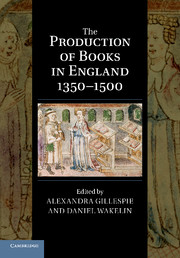Book contents
- Frontmatter
- Contents
- List of illustrations
- List of contributors
- Foreword
- Acknowledgements
- List of abbreviations
- Introduction
- 1 Materials
- 2 Writing the words
- 3 Mapping the words
- 4 Designing the page
- 5 Decorating and illustrating the page
- 6 Compiling the book
- 7 Bookbinding
- 8 Commercial organization and economic innovation
- 9 Vernacular literary manuscripts and their scribes
- 10 Book production outside commercial contexts
- 11 Censorship
- 12 Books beyond England
- 13 English books and the continent
- Afterword: the book in culture
- Bibliography
- Index of manuscripts
- General index
5 - Decorating and illustrating the page
Published online by Cambridge University Press: 05 May 2014
- Frontmatter
- Contents
- List of illustrations
- List of contributors
- Foreword
- Acknowledgements
- List of abbreviations
- Introduction
- 1 Materials
- 2 Writing the words
- 3 Mapping the words
- 4 Designing the page
- 5 Decorating and illustrating the page
- 6 Compiling the book
- 7 Bookbinding
- 8 Commercial organization and economic innovation
- 9 Vernacular literary manuscripts and their scribes
- 10 Book production outside commercial contexts
- 11 Censorship
- 12 Books beyond England
- 13 English books and the continent
- Afterword: the book in culture
- Bibliography
- Index of manuscripts
- General index
Summary
This chapter reviews recent research on the technical processes and identities of the artists who decorated and illustrated English books as well as the forms of illustration in them. It argues that the period between 1350 and the earliest years of printing was one in which book illustration, like other aspects of book production, gradually became a more organized and more commercial activity. Much of the illustration and decoration in manuscripts and printed books of the late fourteenth, fifteenth and sixteenth centuries was anonymous, driven by convention, instructions and models, and organized by commercial producers. Yet that work was also affected by the inconsistency and lack of centralization of processes of production that shape other aspects of book production in this period.
The lack of centralized procedures for illustrating books, or records of these, means that our knowledge of the technical processes of illustrating and decorating books must be drawn from a wide range of sources: recipe books, limning treatises and artists' handbooks; illuminated manuscripts themselves, especially unfinished books showing the stages of decoration; directions to illuminators; contemporary word lists; documentary evidence in wills and legal records; modelbooks and sketchbooks; costings for manuscripts in account books; notes in manuscripts; and images of illuminators. Central to the following discussion are two key terms: ‘limner’ and ‘shop’.
- Type
- Chapter
- Information
- The Production of Books in England 1350–1500 , pp. 104 - 128Publisher: Cambridge University PressPrint publication year: 2011
- 3
- Cited by



